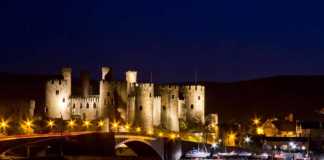A small southeast European country, Bulgaria is known for its beautiful nature and ancient landmarks. The country has been inhabited by Thracians, Romans, Celts, Slavs and later Bulgarians, which formed a powerful alliance with the local tribes. It became a powerful empire in the Balkans during the Middle Ages. During this period, Bulgaria thrived and most of its historical landmarks are testimony to the country’s glorious past.
These days, natural landmarks in Bulgaria attracts visitors to a country endowed with lots of beautiful places to explore. History lovers from around the world come to Bulgaria to explore ancient remains dating back to 4000BC. What’s more, Bulgaria has also become well-known for its cuisine and traditions. Here are some of the best historical and natural landmarks in Bulgaria.
Contents
20 Landmarks in Bulgaria
Landmarks in Sofia
The capital of Bulgaria is the oldest city in Bulgaria and one of the oldest cities in the Balkans dating back to the 5th century BC.
The city has been inhabited by Thracians, Celtics and Slavs before the Romans took control. Then, the Bulgarians came from the east the founded the country of Bulgaria in 681.
Sofia is a city rich in history from various periods and a destination to visit on a Balkan tour as there are lots of things to explore.
While there you will get the chance to observe lots of Roman excavations both around the city and in museums.
Surprisingly, Sofia is a quite modern city and its attractions are a balance of old and new. Here are some famous landmarks in Sofia.
1- Ancient Serdica Complex
In the city centre of Sofia, in the Serdica district, is the Ancient Serdica Complex, which is an open-air ancient complex that is easily accessible and absolutely free to visit.
The ancient Roman houses, baths, streets and a small basilica dating back to the 4th century are impressive.
Another attraction is the Sveta Petka church, which is a small, orthodox church made out of stone and filled with biblical murals.
The church is historically important to the city of Sofia, as it is one of the oldest churches in the city.
2- Banya Bashi Mosque
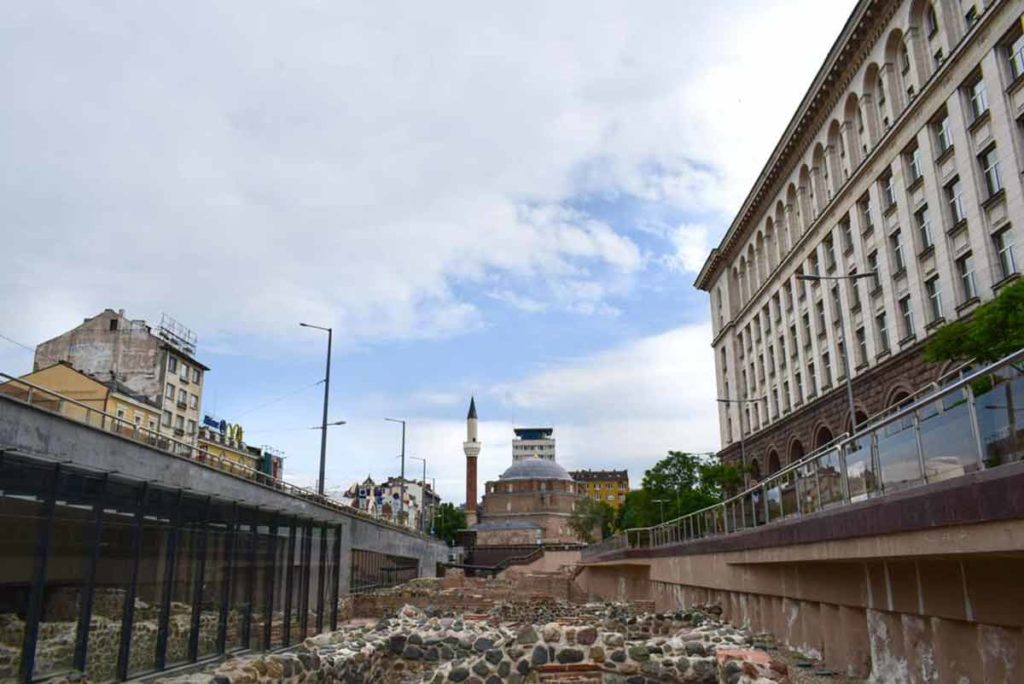
Banya Bashi Mosque is the most famous mosque in Bulgaria.
It was built in the 16th century during the Ottoman era and stands out beside the ancient Serdica complex.
This is the only mosque that was not destroyed after Bulgaria regained its independence in 1878, making it a Bulgarian landmark of great historical importance for the city of Sofia.
3- Aleksander Nevski Cathedral
The Aleksander Nevski Cathedral is not only a symbol of the city of Sofia, but it’s also the largest Orthodox cathedral in southeast Europe and the Balkans.
The Neo-Byzantine style design with its gold-plated domes makes it an impressive landmark in Bulgaria.
The interior is hand-painted by Bulgarian artists during the start of the 20th century and while most of these frescoes depict Biblical scenes but have slowly worn away over the years.
Inside the cathedral are a couple of altars, as well as secret stairways that lead to the upper corridors of the cathedral.
4- National Art Gallery
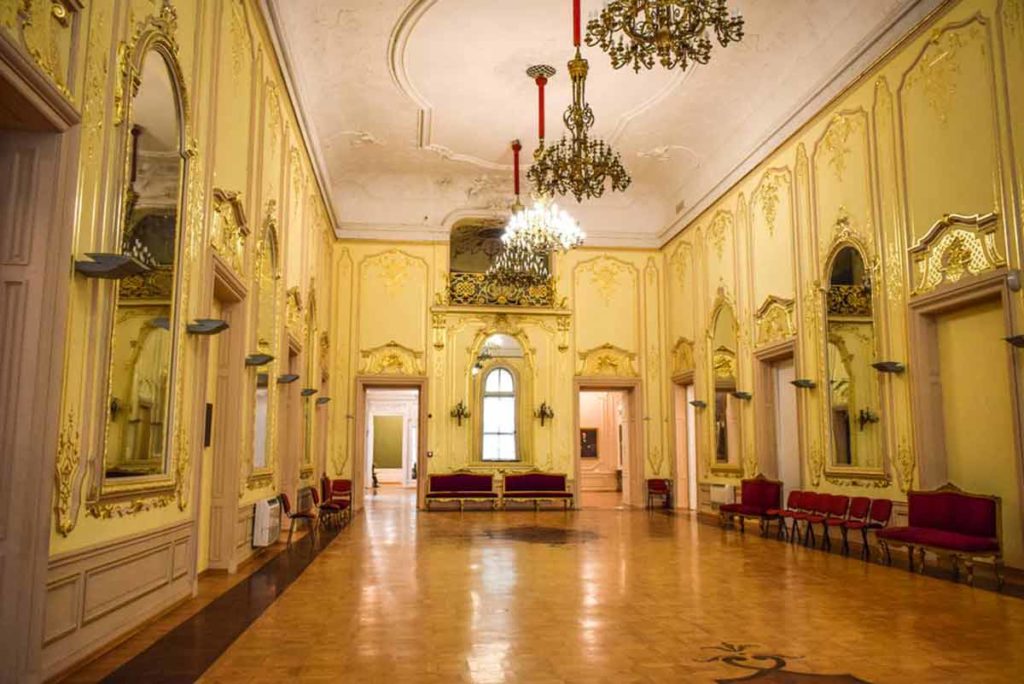
The National Art Gallery of Sofia was once a Turkish residence and event hall.
After the liberation of Bulgaria, it was reconstructed and became a palace for the Bulgarian royal family.
The gallery has two floors, with the first floor displaying temporary exhibitions.
The second-floor houses two galleries – the Bulgarian Art Gallery and the gallery of the royal family – and a museum.
The National Ethnography Museum is packed with cultural exhibits from various periods.
5- Russian Church
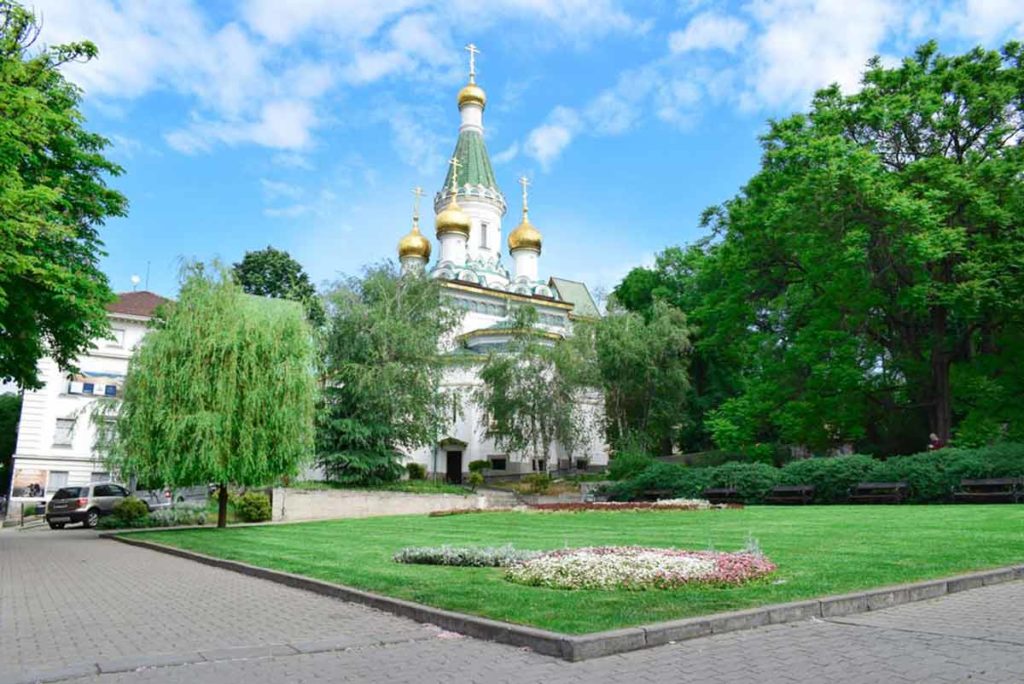
One of the highlights of Sofia is the Russian church, which is among the most beautiful churches in the country.
The Russian Church was built over a destroyed mosque after the liberation of Bulgaria in 1878.
The church is a true gem built in typical Russian architectural style and has five golden domes.
6- Vrana Palace
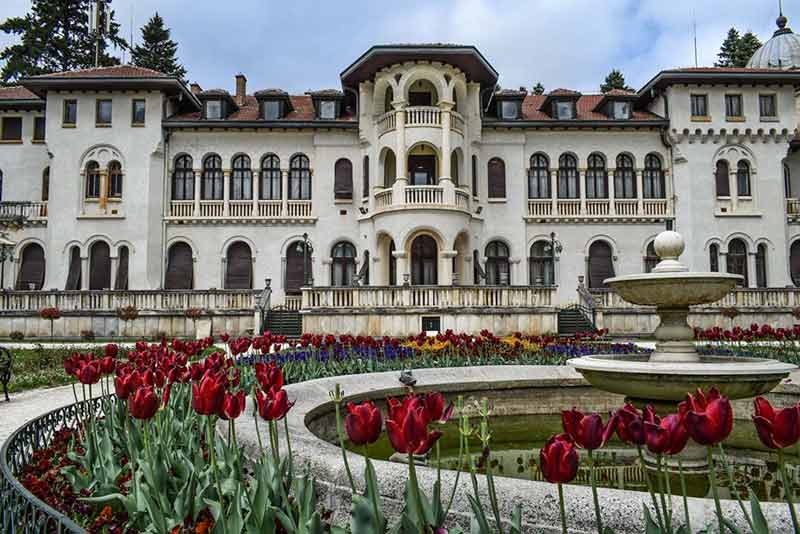
Vrana Palace was another residence built by the Ottoman governor of Sofia. However, after the liberation of Bulgaria, it was gifted to the Bulgarian royal family.
Vrana palace has a huge garden with lots of beautiful gardens surrounding the palace.
Along with that, there are lots of ponds, greenhouses, stables and even a little zoo.
Unfortunately, the palace has turned into a ghost house, since the royal family left the country and it is not using it anymore.
7- Vitosha Mountain
Vitosha Mountain is the closest mountain to Sofia, actually, the city of Sofia is built within the plateaus of Vitosha.
The mountain has some the best hiking trails in Bulgaria to explore and is a popular place for locals to go to relax.
Some of the best hiking trails in Vitosha are the trail to the Dragalevtsi monastery, to Boayan waterfall and to Cherni Peak.
For more amazing European Landmarks, read:
- 30 Spain Landmarks
- 20 Switzerland Landmarks
- 22 Germany Landmarks
- 35 London Landmarks
- 30 France Landmarks
- 20 Italy Landmarks
- 20 Greece Landmarks
- 20 Russia Landmarks
- 20 Scotland Landmarks
- 20 Ireland Landmarks
- 21 Wales Landmarks
- 20 Turkey Landmarks
- 20 England Landmarks
- 20 Hungary Landmarks
- 21 Romania Landmarks
- 20 Ukraine Landmarks
- 20 Athens Landmarks
- 20 Rome Landmarks
- 20 England Landmarks
- 20 Portugal Landmarks
- 20 Poland Landmarks
- 20 Iceland Landmarks
- 20 Bulgaria Landmarks
- 21 Croatia Landmarks
- 20 Bulgaria Landmarks
- 20 Austria Landmarks
- 21 Finland Landmarks
- 20 Sweden Landmarks
- 20 Denmark Landmarks
- 20 Belgium Landmarks
- 20 Netherlands Landmarks
- 20 Barcelona Landmarks
- 21 Czech Republic Landmarks
- 20 Landmarks in Paris
- 20 Landmarks in Liverpool
- 10 Istanbul Landmarks
Landmarks in Plovdiv
Plovdiv is one of the oldest Bulgarian cities and has been known by different names – Philippopolis, Trimontium and Pulpudeva.
It was inhabited by Thracians, Romans, Byzantines and later Bulgarians.
This rich history makes Plovdiv a city of historical and cultural importance and there are many ancient landmarks here to support this claim.
During the Middle Ages, Plovdiv grew to become the cultural centre of the Bulgarian Kingdom.
It’s a period when wealthy Bulgarian families built huge houses in the centre of the city, which is now considered national treasures and a reason why Plovdiv is one of the most attractive cities in Bulgaria.
The city’s historical and cultural richness makes it an interesting place to visit.
8- Old Town of Plovdiv
The old town of Plovdiv and its colourful old houses are one of the highlights in the city.
Most of these two-story houses were owned by the wealthy merchants of Plovdiv in the past and have become museums that display life in Bulgaria during the revival period.
One of the most famous museum houses, the Balabanov House, is a Bulgarian landmark not to be missed.
It is a huge house built in the distinctive revival architectural style and painted in bright red.
You can’t miss it!
9- Ancient Theatre
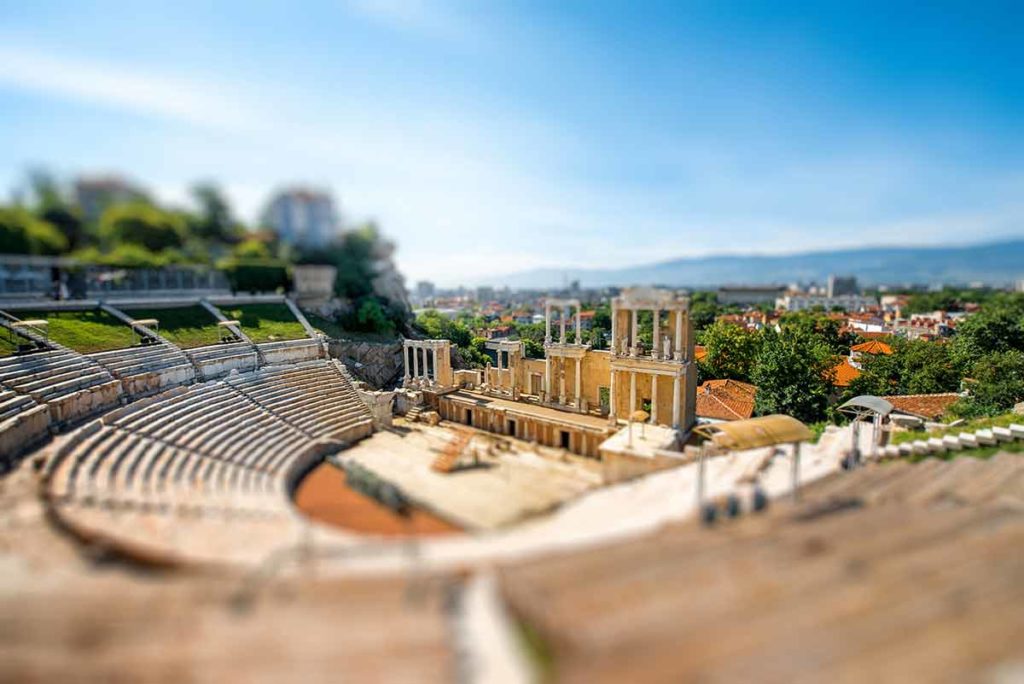
Plovdiv’s ancient theatre is one of the oldest theatres in Bulgaria.
It was built in the first century by the Romans when they ruled these lands.
Its main purpose was to entertain the most important people of that time and the Emperor’s friends.
The ancient theatre was made of white marble blocks and statues, which are well preserved.
An interesting fact is that most of the seats of the theatre are engraved with the names of the people who were close to the Emperor.
There are also artefacts proving that the theatre was used for gladiator fights as well as plays and recitals.
Nowadays, this ancient theatre is not only a historical site, but also a place to attend concerts during the summer months.
10- Roman Stadium
Not far from the Ancient Theatre is the Roman Stadium, which is a landmark that can be reached by going underground and is free of charge.
The Roman Stadium was used for sports games and chariot races, which were entertaining the public, including the Emperor.
It is not as fascinating as the ancient theatre but it is still a worthwhile landmark to see for history lovers.
11- The Dzhumaya Mosque
During the Middle Ages, Plovdiv, like every other Bulgarian city, was under the rule of the Ottoman Empire.
A mosque was built in the city around the 14th century on the site of a Bulgarian church, despite the opposition of the locals.
Today, the Dzhumaya Mosque is situated near the Roman Stadium and houses the city’s best pastry café.
The café in the mosque serves Turkish dishes and pastries that you should definitely try.
The kunefe, Turkish banitsa and baklava are delicious.
12- Kapana District
Kapana district is a lively arty part of Plovdiv.
The neighbourhood is the old merchants and craftsman district that once attracted traders from around the world.
These days, the neighbourhood is a fantastic place to wind and dine in Bulgaria.
There are all kinds of eateries, from tiny cafes to fine restaurants, offering all types of foods, including simple fare like burgers and pastries to traditional dishes presented as fine meals.
There are many bars that have different types of draft beer you won’t find anywhere elsewhere.
13- The Hills of Plovdiv
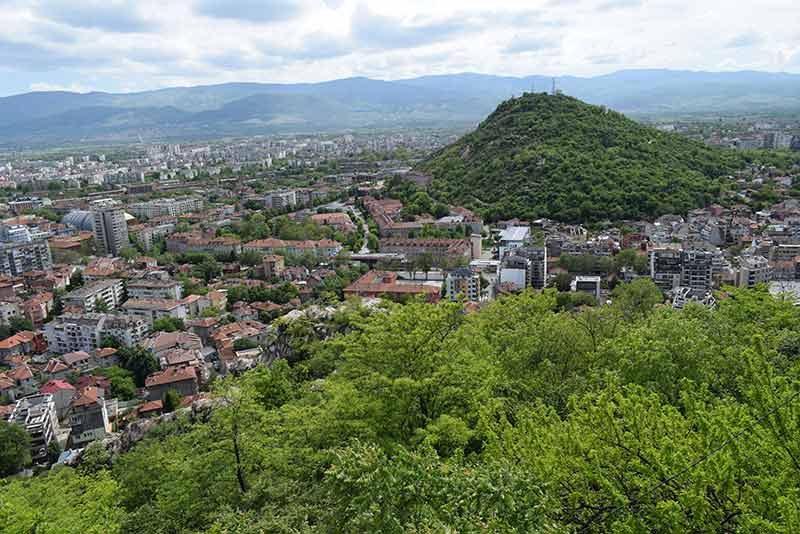
If you are going to Plovdiv, you will have to visit the hills of the city.
Known as tepe by the locals, which is the Turkish word for a hill, these hills offer breathtaking views of the surrounding mountains.
One of the most famous hills in Plovdiv is the Alyosha.
It is the highest of all the Tepes in Plovdiv and once on its top, you will get a beautiful view of the surrounding area.
Another famous hill is the Youth hill, which is a huge park where you can enjoy a nice walk and later on a nice view of Plovdiv.
Nebet Tepe, which is the founding hill of Plovdiv, is where the first inhabitants of the area lived in 4000BC.
Nebet Tepe is fascinating and has remains of the city, along with fortress walls, gates and ancient houses.
Exploring Eastern Europe? You may also like:
- 20 Landmarks in Bulgaria
- 20 Bulgarian Cities
- 20 Things To Do In Sofia
- 22 Landmarks in Hungary
- 20 Cities in Hungary
- 15 Things Hungary Is Famous For
- 22 Castles in Czech Republic
- 21 Landmarks in Czech Republic
- 20 Things To Do In Prague At Night
- 15 Things To Do In Prague
- 20 Day Trips From Belgrade
- 10 Things To Do In Belgrade
- 20 Cities in Serbia
- 20 Things To Do In Baku
- 20 Slovakian Cities and Towns
- 20 Slovenian Cities and Towns
- 20 Latvian Cities and Towns
- 20 Castles in Poland
- 20 Landmarks in Poland
- 20 Polish Drinks
- 20 Cities in Poland
- 20 Things To Do In Warsaw
- 20 Things To Do In Krakow
- 20 Things To Do In Krakow At Night
- 20 Things To Do In Gdansk
- 20 Castles in Romania
- 20 Landmarks in Romania
- 20 Cities in Romania
- 20 Castles in Belarus
- 20 Things To Do In Tbilisi
- 20 Things To Do In Armenia
- 20 Cities In Armenia
- 20 Things To Do In Riga
- 20 Things Romania Is Famous For
Landmarks in Veliko Tarnovo
Veliko Tarnovo is an ancient capital of Bulgaria and was the seat of the Bulgarian royal family for many centuries.
The city was one of the oldest settlements in the region and, like other Bulgarian cities, it was inhabited by Romans, Thracians, Slavs and later Bulgarians.
Around the 10th century, the fortress of Veliko Tarnovo was built to protect the royal family from the advancing southerners.
Even though Veliko Tarnovo, which means Great Tarnovo, was one of the most difficult cities to capture, it fell to Ottoman rule after many battles and its people enslaved.
14- Archaeological Complex Tsarevets
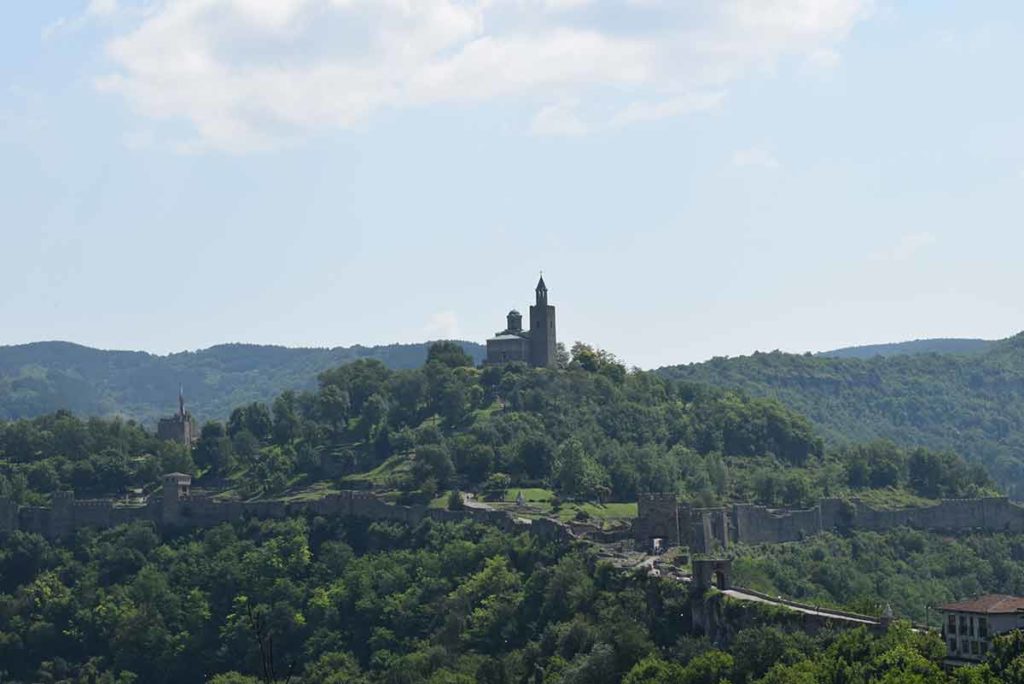
The archaeological complex of Tsarevets is a must-see landmark of Bulgaria.
At the entrance of the fortress of Tarnovo, there are two huge statues of lions put there as a symbol of the power and wealth of the Bulgarian Empire.
Going further and passing by a couple of gates you will find yourself in the courtyard of the fortress, with the tower of Baldwin on the right.
According to legend, the Bulgarian King Kaloyan defeated the Latin Emperor Baldwin and imprisoned him in this tower until his last days.
From the tower, the view over the park of the city and the river Yantra is stunning.
The Ascension Cathedral is the highest point of the fortress and was built there so that the devotees would be closer to God and their prayers heard.
The cathedral is decorated with spooky medieval frescoes.
Back down the hill, Skull Rock is the spot where traitors were thrown into the river.
Nearby are old houses, temples and monasteries and other historic buildings.
All this makes the archaeological complex of Tsarevets a must-see historic landmark of Bulgaria of great importance.
15- Krushuna waterfalls
Another place to visit while travelling around Veliko Tarnovo is Krushuna waterfalls, which are famous natural landmarks in Bulgaria known for clear waters.
To get to the waterfalls, there is a lot climbing to a cave from where the Maara river springs.
The scene at the first waterfall is mesmerising, with crystal-clear water gushing down into lovely ponds and lush forests.
16- Devetashka Cave
Devetashka Cave is another famous Bulgarian landmark in the Veliko Tarnovo region.
The cave has featured in many movies including The Expendables and is the biggest open karst cave in Bulgaria.
It’s home to bat colonies and there’s a special “bat room” where the bats hang out and, despite common belief, the bats are not aggressive.
The cave was inhabited by humans back in the Paleolithic period, making it a landmark of great importance for the Bulgarian archaeological community.
Landmarks in Southeast Bulgaria
The southeast part of Bulgaria is known for its beautiful landscapes and Thracian excavations.
This part of Bulgaria, although hard to get to, is the best part of the country to visit for its legacy of well-kept traditions by the descendants of the Thracians.
It has a mild climate (even in winter), good wine, the best cuisine in southeast Bulgaria and fascinating landmarks.
17- Thracian Village Tatul
The ancient village of Tatul may be small but it is quite fascinating.
At its entrance, there is a huge ancient building that survived from the period of antiquity and according to archaeologists, it was a temple used for sacrifices and worshipping of pagan gods.
There are lots of other temples and sarcophaguses carved into the rocks on the top of the hill.
Many claim that one of these sarcophaguses was Orpheus, an ancient prophet and musician.
The other sarcophagus is believed to be of the Thracian King Rhesus, who fought in the Trojan war.
The Thracian village is surrounded by a beautiful forest and once you get on top of it, where the sarcophaguses are, a mesmerising view.
18- The Petrified Wedding
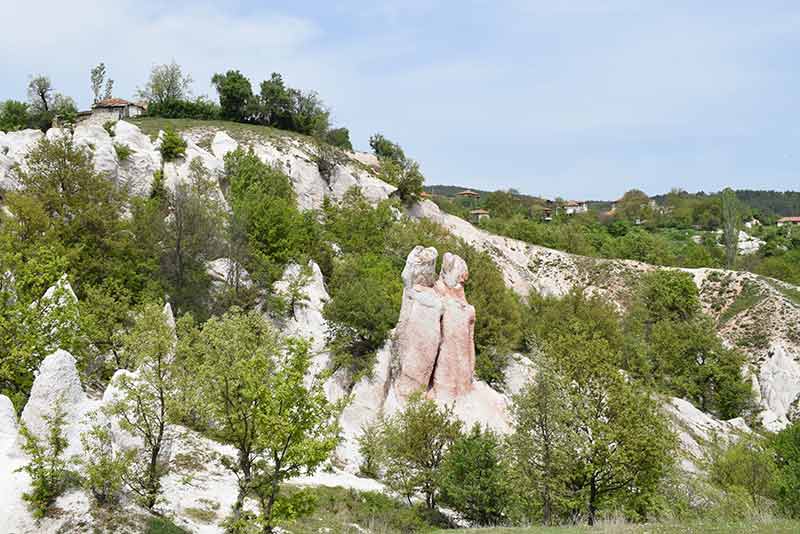
The Petrified Wedding is a natural landmark in southeast Bulgaria consisting of two huge rocks next to each other.
Around them are lots of other small rocks, which is why the locals named it ‘The Wedding’.
As the legend goes, a very beautiful girl was marrying a man, whose father was envious of his son.
To punish the father, the gods froze everyone attending the wedding and that is how we got the Petrified Wedding.
19- Ancient City of Perperikon
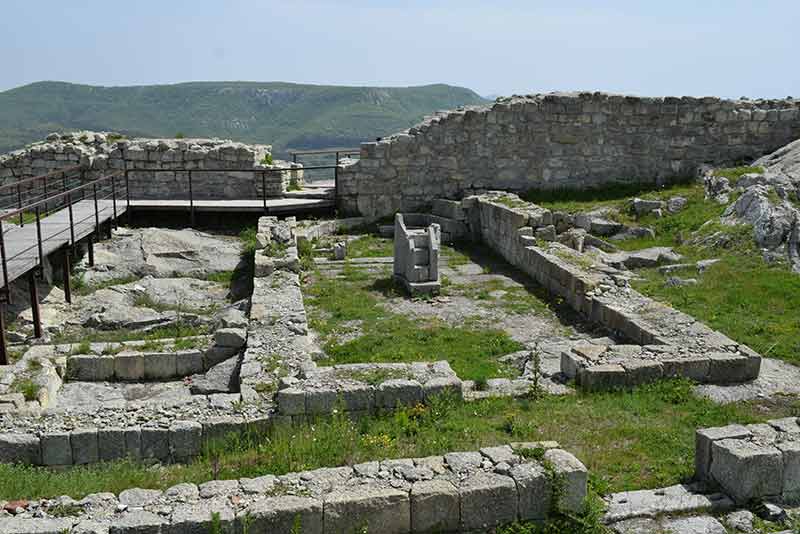
The ancient city of Perperikon is the gem of southern Bulgaria.
Sitting on a high plateau, it is one of the places that will leave you in awe.
To reach the ancient city, you will have to climb over rocks leading to the first pagan temple of the ancients.
Inside of this temple was a throne dedicated to the villages most beautiful girl, who was a shaman who drank infusions that put her into a deep trance where she was able to foresee the future.
Further up, there are other ancient remains from a later period related to the worshipping of the pagan gods.
Besides temples, there are the remains of the ancient palace and fortress of Perperikon.
Inside one of the temples, there is a marble throne, which is considered to be the throne of the oldest church built in Bulgaria.
Perperikon is an impressive landmark in Bulgaria and the highlight of any trip to the southern region.
It’s a holy place with mystical energy.
Landmarks in Northwestern Bulgaria
The northwestern region of Bulgaria is packed with historical and natural landmarks, many of which are difficult to reach or are less known.
Northwest Bulgaria is the least visited region of the country but one of the most interesting.
20- Zlatna Panega Eco Trail
Zlatna Panega is one of the most-visited eco trails in the north of Bulgaria and a beautiful place to go on a relatively easy hike to enjoy the serenity of nature.
The hiking trail of Zlatna Panega follows the Zlatna Panega River, which flows over karst stones and has clear blue water.
Hike through stone arches, staggering karst cliffs and stunningly clear water along this short and relatively easy trail.
An interesting fact is that there is a cave called the Temnata Dupka, which has lots of remains from the Paleolithic period.
It’s a laid-back destination an hour from Bulgaria.
21- Prohodna Cave
Prohodna Cave is a famous cave in Bulgaria.
The cave is easily accessible and is also known as the longest cave tunnel of 365 meters in Bulgaria.
Due to erosion from water and wind, two huge holes have appeared on its ceiling known as the Eyes of God.
Prohodna Cave is well lit by natural light falling through the Eyes of God, which makes it good exploration and is one of the few caves where bungee jumping is allowed.
Discover more Famous World Landmarks:
- 25 Australian Landmarks
- 20 New Zealand Landmarks
- 20 African Landmarks
- 21 Egyptian Landmarks
- 20 Jordan Landmarks
- 10 Tasmanian Landmarks
- 20 Antarctica Landmarks
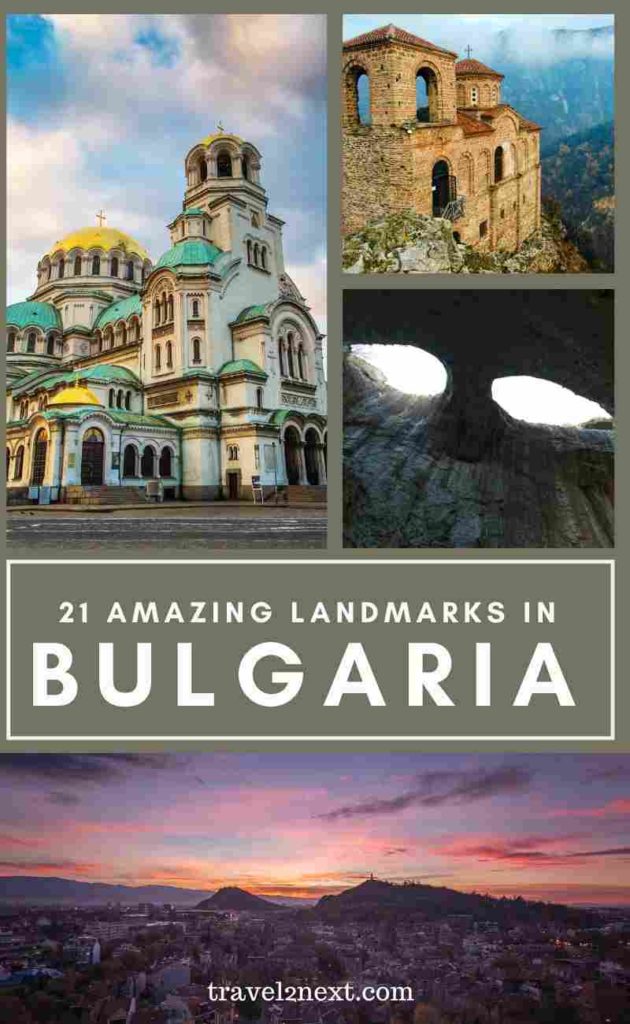
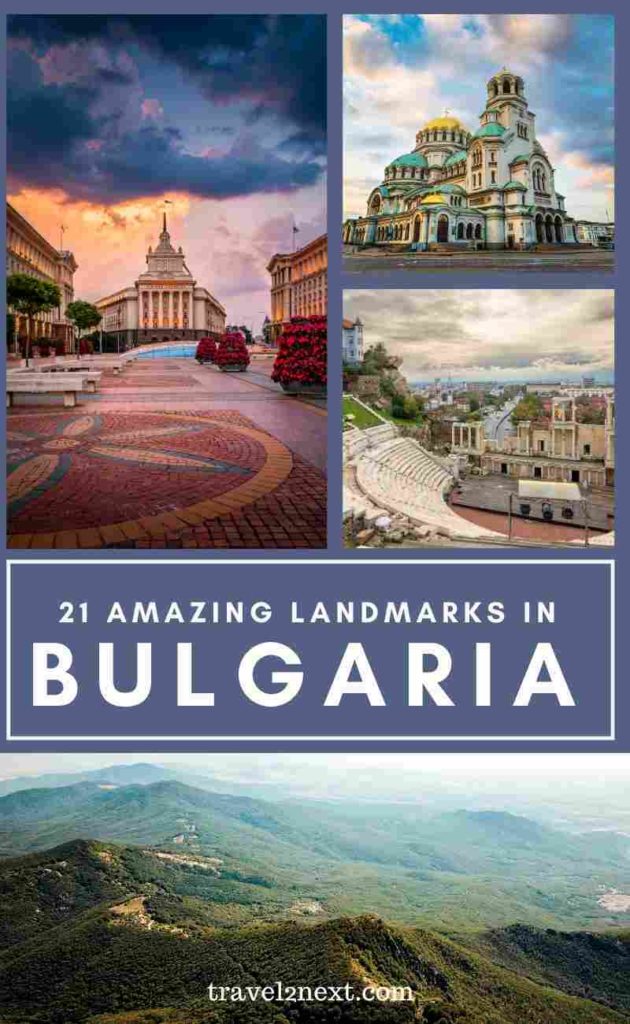
Plan Your Trip

Rent A Car – Find the best car rental rates at Discover Cars. They compare car hire companies to provide you with the best deal right now.
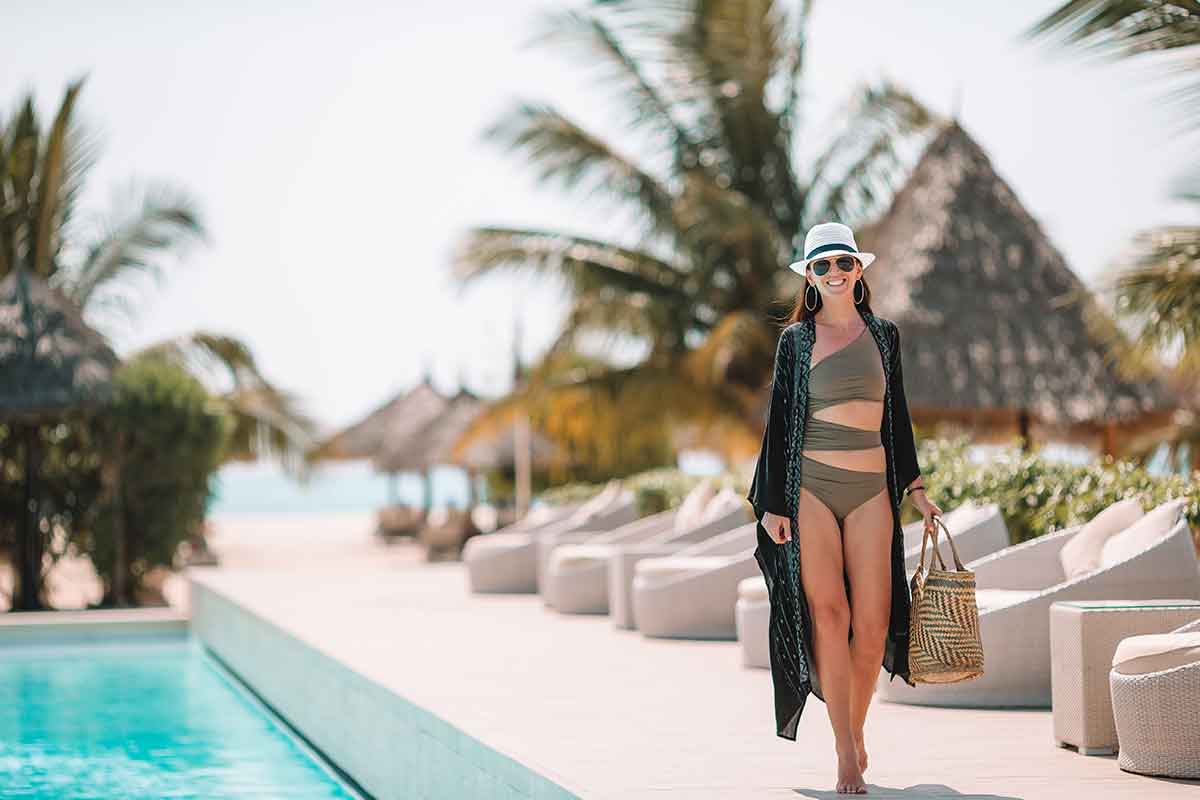
Find A Hotel – If you’re curious about this article and are looking for somewhere to stay, take a look at these amazing hotels.
